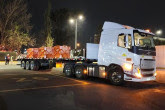
By Vasiliki Tafili, IAEA Department of Nuclear Safety and Security
A record number of 31 disused sealed radioactive sources (DSRSs) were removed from Chile earlier this year, and transferred to a recycling facility abroad, in a large removal operation supported by the IAEA. The removed radioactive sources were mainly cobalt sources previously used for cancer treatment in Chile’s hospitals and clinics. Since the end of their use in 1992, they have been in temporary storage at a specialized facility managed by the Chilean Nuclear Energy Commission (CCHEN).
The DSRSs transfer operation is part of an IAEA interregional project aimed at improving nuclear safety and security by providing comprehensive technical assistance for the sustainable management of DSRSs.
“Chile’s case of DSRSs management is a successful example of how effective international cooperation can benefit national and global nuclear security,” said Director of the IAEA’s Division of Nuclear Security Elena Buglova. “The IAEA strongly encourages countries to establish a national policy and strategy for safe and secure DSRSs management, and offers its assistance to those countries that would like to invest in a sustainable approach.”
In Chile, radioactive material and sealed radioactive sources are used mostly for industrial applications, for example in measuring parameters such as thickness and density of materials; in medicine for diagnosis and treatment purposes; as well as for research purposes. The DSRSs represent about half of the radioactive material received yearly in waste management facilities from different activities around the country.
“The removal of these sources has multiple benefits for the CCHEN and the whole country, and it is in line with the circular economy objectives, in terms of recycling and reuse,” said Executive Director at the Chilean Nuclear Energy Commission Luis Huerta Torchio,. “The removal has significantly reduced the risk for any type of incident associated with these disused sources. In addition, it freed up to 30 per cent of space in the national storage facility used for disused radioactive sources, and subsequently extended the possibility of its use for about ten more years,” he added.
The operational plan was agreed among involved parties, namely the IAEA, the end-user representing Chile, and the contractor, in December 2021. The operation involved the physical and the radiological verification of the radioactive sources, the appropriate packaging for transport, the transportation, and as a last step, the shipment and export to a recycling facility in Europe. The export of the first 17 sources was made in October 2022, while 14 more were exported in July 2023.
“The IAEA technically oversaw the removal of the sources from Chile to ensure that it was performed safely and securely. An operation of this scale cannot succeed without the dedicated efforts of organizations like CCHEN, skilled contractors, and the regulatory bodies involved,” said Director of the IAEA’s Division of Nuclear Fuel Cycle and Waste Technology, Olena Mykolaichuk adding that “the experience gained is invaluable and represents a model that can be applied for future projects in other countries.”
IAEA project helps 34 countries with management of disused sealed radioactive sources
Effective and continuous regulatory and management control of radioactive sources is of utmost importance in preventing unauthorized use, accidents or malicious acts with harmful radiological consequences. Once sealed radioactive sources reach the end of their useful life, the safe, secure and sustainable long term management of DSRSs is essential to reduce radiation hazards to the public and the environment. This is because DSRSs may still contain large amounts of radioactivity and may emit ionizing radiation.
Common needs and goals for the safe, secure and sustainable management of DSRSs through their entire life cycles are addressed under an IAEA project launched in 2019 and funded by Canada, which is currently in its first phase and includes countries from Latin America, Africa and the Pacific region. Increased interest in this project has resulted in the implementation of a second phase of the project, inaugurated in November 2022 with 24 newcomer countries — more than double the number of countries which joined the first phase. The second phase of the project will last three years and will take on a broadened scope to address new needs related to the long-term management of DSRSs.
“The increase in the number of participating countries indicates the success of the first phase of the project, the global interest in the safe and secure handling of DSRSs and, at the same time, the amount of work that remains to be done in this field,” said Director of the IAEA’s Division of Radiation, Transport and Waste Safety Hildegarde Vandenhove,. “It also underscores the importance of collective efforts to support and sustain such a technical assistance mechanism. It is an IAEA priority to build sustainable capacity for the management of DSRSs.”



